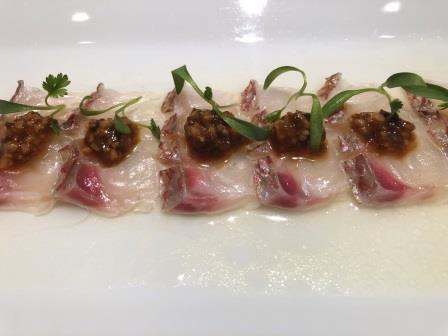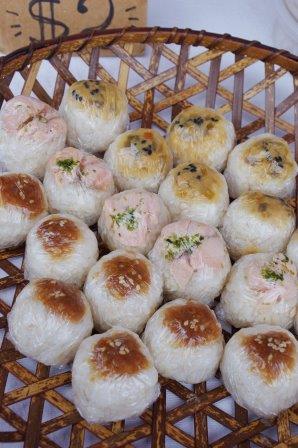Casual and authentic noodles you can enjoy at the secret hideout of a high-end kaiseki cuisine restaurant
By Aya Ota
“Brushstroke” is a kaiseki cuisine restaurant collaboration by chef Bouley, a leading French chef in New York, and TSUJI Culinary Institute. Even now, 7 years after the opening, their dishes, in which tradition and innovation are harmonized well by using local capturing New Yorker’s hearts, and raved highly by various media outlets.
“Noodle Bar” has been running since the end of last year in a corner of this restaurant “Brushstroke”, and has become the talk of the town.
“I am so excited about this new attempt,” says Isao Yamada, Executive Chef, with his eyes shining. “Noodle Bar” is a space that looks like a hideout with only 14 seats, which is located on the opposite side of the main dining area. Whenever its purpose changed, some changes were made to this space, and collected a lot of attention every time. It used to be the cocktail bar when first opened, and then changed to the omakase-style sushi bar. After closing the sushi bar, the space was closed unused for over half a year while the next concept of the project was being thought out. “People tend to think kaiseki cuisine is not very approachable, so we want different types of customers,” they thought. After the trial and error period, Chef Kyoji Noda, who has experience in showing skills at a ramen restaurant in the past, they came up with the noodle bar concept based on the trial ramen dish he created, which grew bigger in no time.
There are 5 noodle dishes on the menu. The most popular dish is “Brushstroke Tonkotsu Ramen” ($17). Incidentally, both Chef Yamada and Chef Noda are from Fukuoka which is known for Tonkotsu ramen. This is the dish created by those two with ultimate particularity. The soup that has been cooked for 4 days by cracking pork bones in the process is so rich that a film of collagen forms in a few minutes after the bowl is served at the table. It looks like a typical bowl of tonkotsu ramen; however, it tastes classically delicate, and makes a clear distinction from other tonkotsu ramen bowls. It is worth carrying the honorable restaurant name. In the “Duck Original 7 Miso Ramen” ($17), the original blend of miso is mixed into the soup which has been cooked one full day until the soup turns white and cloudy. The soup turns out to have a mild taste by blending various types of miso, white, red, inaka, moromi, etc., and matches extremely well with the tenderly cooked duck chashu.
The corn/kombu dashi based “Roasted Sweet Corn Butter Soy Sauce Ramen” ($15) is uniquely sweet and creamy, and has an interesting twist of changing the taste by adding cumin as you eat. There are 2 udon dishes. “Maine Lobster Kishimen Udon” ($26) which has springy and chewy lobster pieces on top of the soy milk based lobster umami flavored soup, and “Sashimi Kishimen Udon” ($57), where plentiful of seasonal sashimi pieces are served with dashi in which bonito shavings are generously used.
高級懐石料理店の隠れ家で食べる、カジュアルで本格的なヌードル
ニューヨークを代表する仏料理シェフ・ブーレイと辻調理師専門学校の提携による懐石料理店『Brushstroke』。四季折々の地元食材を取り入れた、伝統と斬新さが調和する料理は、開店後7年経った今でもニューヨーカーを虜にし、数々のメディアで賞賛され続けている。この『Brushstroke』の一角で、昨年暮れから『Noodle Bar』がスタートし、話題になっている。
「この新しい試みにワクワクしている」と目を輝かせて語るのは、料理長を務める山田勲氏。『Noodle Bar』が設置されているのは、メインダイニングとは反対側に位置する、たった14席しかない隠れ家のような空間。開店当初はカクテルバー、その後はおまかせ寿司バーと、内容が変わるたびに注目を浴びながら変遷してきたスペースだが、寿司バー閉店後は、次の構想を練りながら半年以上も閉めていたという。「懐石料理はどうしても敷居が高いと思われがち。これまでとは違う客層を呼びたい」と試行錯誤する中、ラーメン店で腕を振るった経験を持つ野田恭司シェフが試作したラーメンに着想を得て、一気にヌードルバーの構想が膨らんだ。
麺類メニューは5種類。一番人気は「Brushstrokeとんこつラーメン」($17)。奇しくも、山田・野田両氏は、とんこつラーメンで有名な福岡出身で、その二人がこだわり抜いて創り上げた一品だ。豚骨を砕きながら丸4日間煮込んで作るスープは、テーブルに運ばれてわずか数分で表面にコラーゲン膜が浮かぶほど濃度が高い。見た目は王道のとんこつラーメンだが、上品で繊細な味に仕上がり、店名を冠するだけあり他店とは一線を画する。「鴨ネギ 7種合わせ味噌ラーメン」($17)は、ローストした鴨骨を、白濁するまで丸一日煮込んだスープに、独自配合の味噌を合わせる。白、赤、田舎味噌、もろみ…など複数の味噌を合わせることで、より複雑でまろやかな風味になり、ほろりと柔らかい鴨肉チャーシューとの相性も抜群だ。
トウモロコシと昆布で出汁をとった「醤油バターコーンラーメン」($15)は、甘さとクリーミーさが特徴的で、途中クミンを加えて味を変えるという趣向がおもしろい。うどんは2種類、ロブスターの旨味が効いた豆乳ベースのスープにぷりぷりとした食感のロブスターが乗った「ロブスター豆乳きし麺うどん」($26)、鰹節を贅沢に使った出汁に旬の刺身をふんだんに盛り付けた「刺身きし麺うどん」($57)がある。5種類すべて違うスープと具材を用意し、どれも他店では食べられない創意工夫に富んだ内容だ。季節限定「春野菜チキンラーメン」($17)を提供しているのも、さすが季節感を大事にする懐石料理店ならではだ。
サイドメニューもバラエティ豊か。宮崎和牛やホタテをぎっしり詰めた餃子、和牛ミンチやソフトシェルクラブを挟んだバンズ、鴨のもも肉の竜田揚げなど、カジュアルな仕上がりだが特別感がある。一人で来店しても、ラーメンに合わせやすいようにという心配りで、小ぶりなサイズかつ手頃な値段で提供される。ヌードルバーのメニューは、懐石料理店とは一切かぶらず、すべて別に用意しているという、徹底したこだわりにも驚かされる。オリジナル・カクテルも、懐石料理店とヌードルバーでは違うメニューを楽しめる。
「懐石料理とは違う客にアプローチしたい」という目論見は見事にヒット。 “高級懐石料理店が創るヌードル”という特別感に心引かれるのだろう、ヌードルバーには新規顧客が気軽に訪れるようになった。また、懐石料理店の常連客もヌードルバーに訪れ、両方の客が好循環を生み出している。トライベッカ地区にこれまで本格的なヌードル店がなかったこともあり、地元客も多く訪れているという。
高級懐石料理店の隠れ家で食べるラーメンやうどん…このギャップが、この上ない特別感を演出してくれる。
Noodle Bar at Brushstroke
30 Hudson Street
New York, NY 10013
(212) 791-3771
https://brushstrokenyc.com/
Mon.-Sat. 5:30pm-10:30pm
Lunch on Fridays and Saturdays
(from 11:30am to 2:45pm)
“Brushstroke” is a kaiseki cuisine restaurant collaboration by chef Bouley, a leading French chef in New York, and TSUJI Culinary Institute. Even now, 7 years after the opening, their dishes, in which tradition and innovation are harmonized well by using local capturing New Yorker’s hearts, and raved highly by various media outlets.
“Noodle Bar” has been running since the end of last year in a corner of this restaurant “Brushstroke”, and has become the talk of the town.
“I am so excited about this new attempt,” says Isao Yamada, Executive Chef, with his eyes shining. “Noodle Bar” is a space that looks like a hideout with only 14 seats, which is located on the opposite side of the main dining area. Whenever its purpose changed, some changes were made to this space, and collected a lot of attention every time. It used to be the cocktail bar when first opened, and then changed to the omakase-style sushi bar. After closing the sushi bar, the space was closed unused for over half a year while the next concept of the project was being thought out. “People tend to think kaiseki cuisine is not very approachable, so we want different types of customers,” they thought. After the trial and error period, Chef Kyoji Noda, who has experience in showing skills at a ramen restaurant in the past, they came up with the noodle bar concept based on the trial ramen dish he created, which grew bigger in no time.
There are 5 noodle dishes on the menu. The most popular dish is “Brushstroke Tonkotsu Ramen” ($17). Incidentally, both Chef Yamada and Chef Noda are from Fukuoka which is known for Tonkotsu ramen. This is the dish created by those two with ultimate particularity. The soup that has been cooked for 4 days by cracking pork bones in the process is so rich that a film of collagen forms in a few minutes after the bowl is served at the table. It looks like a typical bowl of tonkotsu ramen; however, it tastes classically delicate, and makes a clear distinction from other tonkotsu ramen bowls. It is worth carrying the honorable restaurant name. In the “Duck Original 7 Miso Ramen” ($17), the original blend of miso is mixed into the soup which has been cooked one full day until the soup turns white and cloudy. The soup turns out to have a mild taste by blending various types of miso, white, red, inaka, moromi, etc., and matches extremely well with the tenderly cooked duck chashu.
The corn/kombu dashi based “Roasted Sweet Corn Butter Soy Sauce Ramen” ($15) is uniquely sweet and creamy, and has an interesting twist of changing the taste by adding cumin as you eat. There are 2 udon dishes. “Maine Lobster Kishimen Udon” ($26) which has springy and chewy lobster pieces on top of the soy milk based lobster umami flavored soup, and “Sashimi Kishimen Udon” ($57), where plentiful of seasonal sashimi pieces are served with dashi in which bonito shavings are generously used.
高級懐石料理店の隠れ家で食べる、カジュアルで本格的なヌードル
ニューヨークを代表する仏料理シェフ・ブーレイと辻調理師専門学校の提携による懐石料理店『Brushstroke』。四季折々の地元食材を取り入れた、伝統と斬新さが調和する料理は、開店後7年経った今でもニューヨーカーを虜にし、数々のメディアで賞賛され続けている。この『Brushstroke』の一角で、昨年暮れから『Noodle Bar』がスタートし、話題になっている。
「この新しい試みにワクワクしている」と目を輝かせて語るのは、料理長を務める山田勲氏。『Noodle Bar』が設置されているのは、メインダイニングとは反対側に位置する、たった14席しかない隠れ家のような空間。開店当初はカクテルバー、その後はおまかせ寿司バーと、内容が変わるたびに注目を浴びながら変遷してきたスペースだが、寿司バー閉店後は、次の構想を練りながら半年以上も閉めていたという。「懐石料理はどうしても敷居が高いと思われがち。これまでとは違う客層を呼びたい」と試行錯誤する中、ラーメン店で腕を振るった経験を持つ野田恭司シェフが試作したラーメンに着想を得て、一気にヌードルバーの構想が膨らんだ。
麺類メニューは5種類。一番人気は「Brushstrokeとんこつラーメン」($17)。奇しくも、山田・野田両氏は、とんこつラーメンで有名な福岡出身で、その二人がこだわり抜いて創り上げた一品だ。豚骨を砕きながら丸4日間煮込んで作るスープは、テーブルに運ばれてわずか数分で表面にコラーゲン膜が浮かぶほど濃度が高い。見た目は王道のとんこつラーメンだが、上品で繊細な味に仕上がり、店名を冠するだけあり他店とは一線を画する。「鴨ネギ 7種合わせ味噌ラーメン」($17)は、ローストした鴨骨を、白濁するまで丸一日煮込んだスープに、独自配合の味噌を合わせる。白、赤、田舎味噌、もろみ…など複数の味噌を合わせることで、より複雑でまろやかな風味になり、ほろりと柔らかい鴨肉チャーシューとの相性も抜群だ。
トウモロコシと昆布で出汁をとった「醤油バターコーンラーメン」($15)は、甘さとクリーミーさが特徴的で、途中クミンを加えて味を変えるという趣向がおもしろい。うどんは2種類、ロブスターの旨味が効いた豆乳ベースのスープにぷりぷりとした食感のロブスターが乗った「ロブスター豆乳きし麺うどん」($26)、鰹節を贅沢に使った出汁に旬の刺身をふんだんに盛り付けた「刺身きし麺うどん」($57)がある。5種類すべて違うスープと具材を用意し、どれも他店では食べられない創意工夫に富んだ内容だ。季節限定「春野菜チキンラーメン」($17)を提供しているのも、さすが季節感を大事にする懐石料理店ならではだ。
サイドメニューもバラエティ豊か。宮崎和牛やホタテをぎっしり詰めた餃子、和牛ミンチやソフトシェルクラブを挟んだバンズ、鴨のもも肉の竜田揚げなど、カジュアルな仕上がりだが特別感がある。一人で来店しても、ラーメンに合わせやすいようにという心配りで、小ぶりなサイズかつ手頃な値段で提供される。ヌードルバーのメニューは、懐石料理店とは一切かぶらず、すべて別に用意しているという、徹底したこだわりにも驚かされる。オリジナル・カクテルも、懐石料理店とヌードルバーでは違うメニューを楽しめる。
「懐石料理とは違う客にアプローチしたい」という目論見は見事にヒット。 “高級懐石料理店が創るヌードル”という特別感に心引かれるのだろう、ヌードルバーには新規顧客が気軽に訪れるようになった。また、懐石料理店の常連客もヌードルバーに訪れ、両方の客が好循環を生み出している。トライベッカ地区にこれまで本格的なヌードル店がなかったこともあり、地元客も多く訪れているという。
高級懐石料理店の隠れ家で食べるラーメンやうどん…このギャップが、この上ない特別感を演出してくれる。
Noodle Bar at Brushstroke
30 Hudson Street
New York, NY 10013
(212) 791-3771
https://brushstrokenyc.com/
Mon.-Sat. 5:30pm-10:30pm
Lunch on Fridays and Saturdays
(from 11:30am to 2:45pm)





























